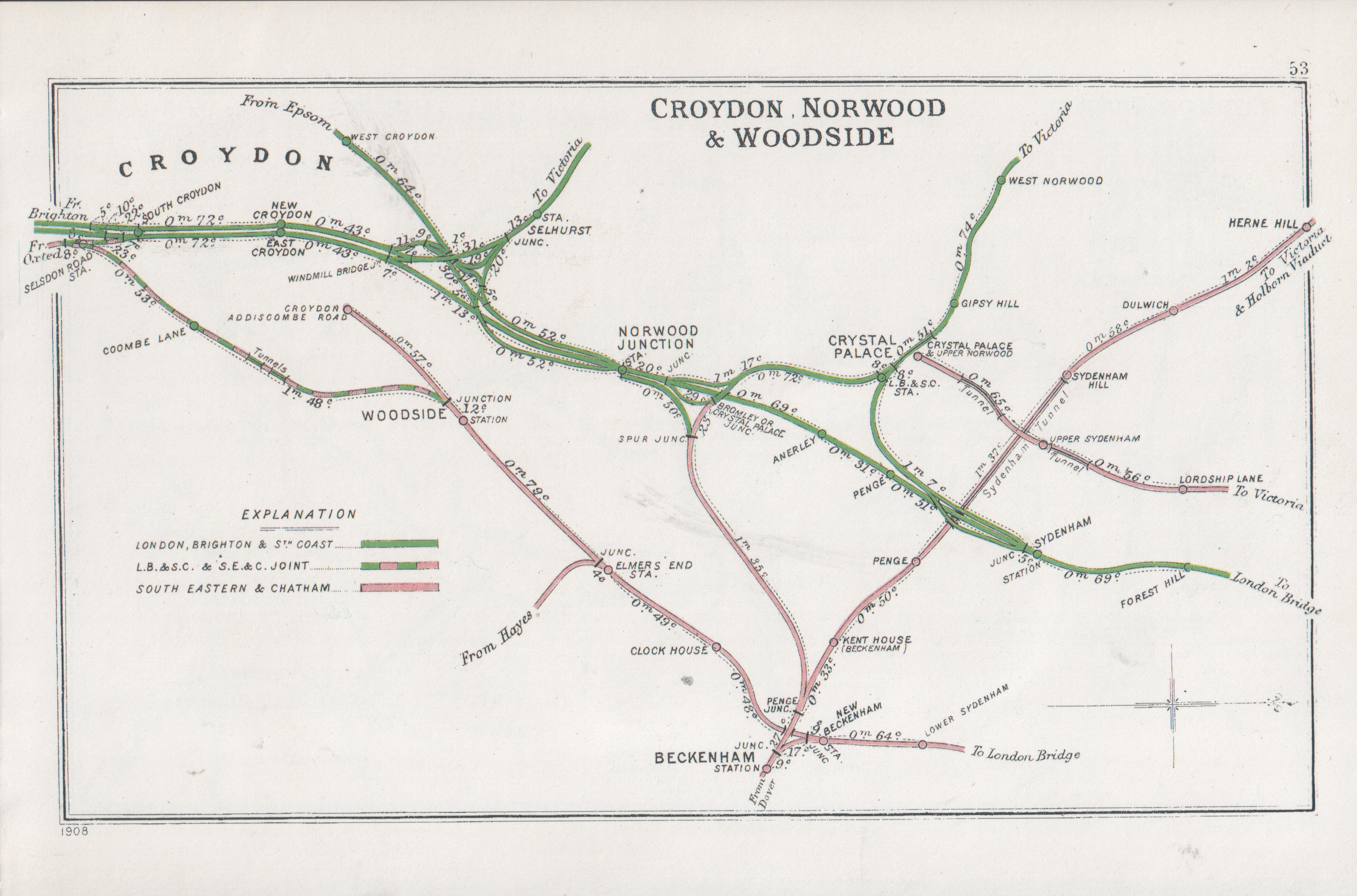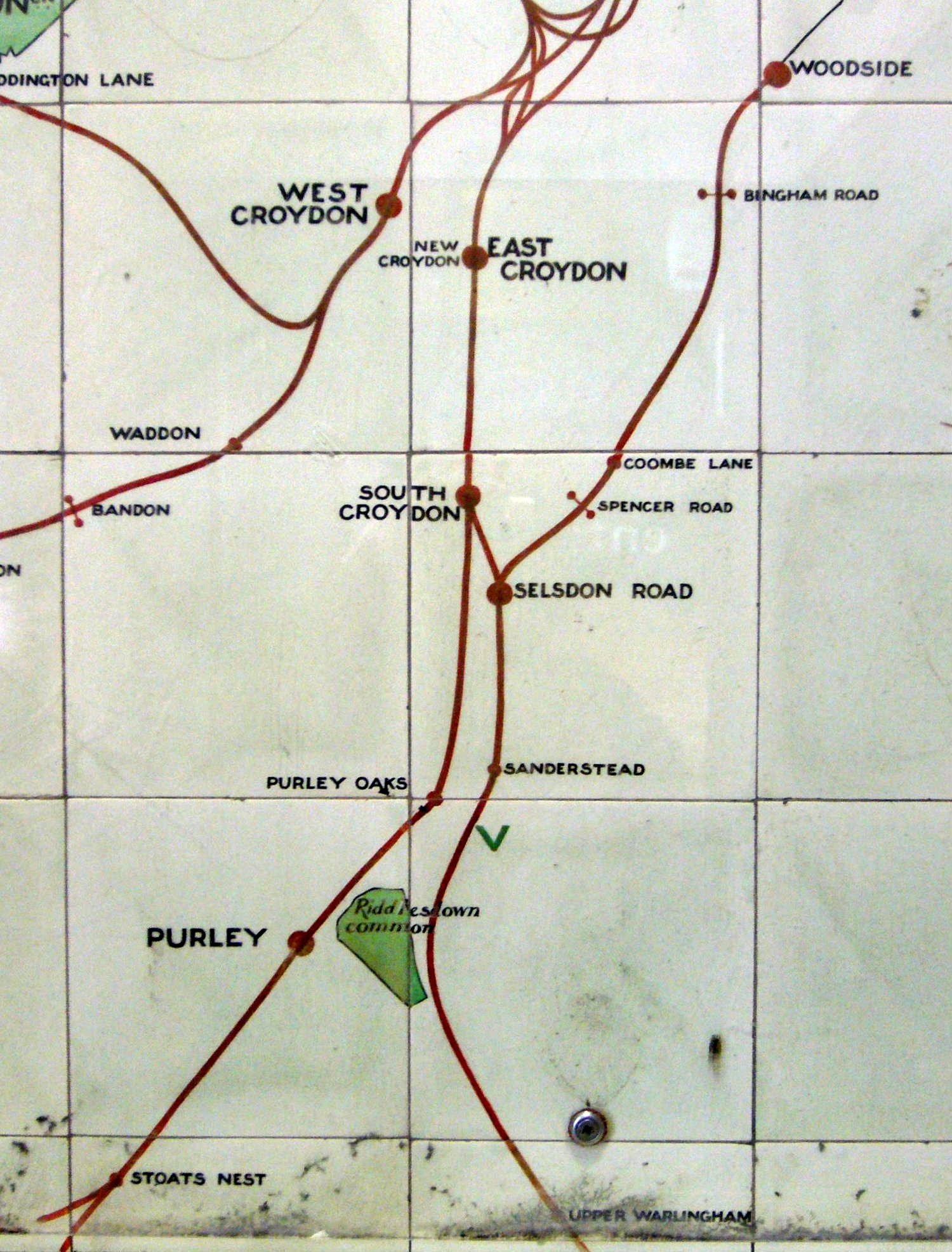|
Selsdon Railway Station
Selsdon railway station was at the junction of the Croydon, Oxted and East Grinstead Railway and the now-closed Woodside and South Croydon Joint Railway. Opened in 1885 as "Selsdon Road" and it was from Selsdon village. History It was jointly operated by the South Eastern Railway (SER) and the London, Brighton and South Coast Railway (LBSCR) prior to the grouping of railways. The four platforms (two for the Woodside line, two for the Oxted line) were respectively decked out in SER and LBSCR signage and fittings. A subway provided access to the Woodside platforms from the main station building. The station closed as a wartime economy measure on 1 January 1917. The Oxted platforms reopened on 1 May 1919, closing on 14 June 1959. At closure these platforms were used by only three trains a day. The Woodside line was retained for occasional special services, and reopened with a regular passenger operation upon electrification of the line to Sanderstead on 30 September 1935. The ... [...More Info...] [...Related Items...] OR: [Wikipedia] [Google] [Baidu] |
Oxted Line
The Oxted line is a railway in southern England and part of the Southern franchise. The railway splits into two branches towards the south and has direct trains throughout to London termini. It was opened jointly by the London, Brighton and South Coast Railway and the South Eastern Railway in the 19th century. The line branches from the London to Brighton Main Line (which has two diverging northern branches) at South Croydon in Greater London. The line then passes under the North Downs in two tunnels, and then splits into two branches at Hurst Green, adjoining Oxted in Surrey. One of these branches ends at East Grinstead, the other at Uckfield, both market towns in Sussex. The line between and is double-track throughout, as is all of the branch. The branch has two tracks as far as ; the rest of the line is mostly single-track, but with two short double-track sections (a passing loop at , and a short distance between and just north of ). History Conception A line was ... [...More Info...] [...Related Items...] OR: [Wikipedia] [Google] [Baidu] |
Cattle Pen
A pen is an enclosure for holding livestock. It may also perhaps be used as a term for an enclosure for other animals such as pets that are unwanted inside the house. The term describes types of enclosures that may confine one or many animals. Construction and terminology vary depending on the region of the world, purpose, animal species to be confined, local materials used and tradition. ''Pen'' or ''penning'' as a verb refers to the act of confining animals in an enclosure. Similar terms are kraal, boma (enclosure), boma, and corrals. Encyclopædia Britannica notes usage of the term "kraal" for elephant corrals in India, Sri Lanka, and Thailand. Australia and New Zealand In Australia and New Zealand a ''pen'' is a small enclosure for livestock (especially sheep or cattle), which is part of a larger construction, e.g. ''calf pen'', ''forcing pen'' (or yard) in sheep or cattle Yard (land), yards, or a ''sweating pen'' or ''catching pen'' in a shearing shed. In Australian and ... [...More Info...] [...Related Items...] OR: [Wikipedia] [Google] [Baidu] |
Railway Stations In Great Britain Closed In 1983
Rail transport (also known as train transport) is a means of transport that transfers passengers and goods on wheeled vehicles running on rails, which are incorporated in Track (rail transport), tracks. In contrast to road transport, where the vehicles run on a prepared flat surface, rail vehicles (rolling stock) are directionally guided by the tracks on which they run. Tracks usually consist of steel rails, installed on Railroad tie, sleepers (ties) set in track ballast, ballast, on which the rolling stock, usually fitted with metal wheels, moves. Other variations are also possible, such as "slab track", in which the rails are fastened to a concrete foundation resting on a prepared subsurface. Rolling stock in a rail transport system generally encounters lower friction, frictional resistance than rubber-tyred road vehicles, so passenger and freight cars (carriages and wagons) can be coupled into longer trains. The rail transport operations, operation is carried out by a ... [...More Info...] [...Related Items...] OR: [Wikipedia] [Google] [Baidu] |
Railway Stations In Great Britain Opened In 1919
Rail transport (also known as train transport) is a means of transport that transfers passengers and goods on wheeled vehicles running on rails, which are incorporated in Track (rail transport), tracks. In contrast to road transport, where the vehicles run on a prepared flat surface, rail vehicles (rolling stock) are directionally guided by the tracks on which they run. Tracks usually consist of steel rails, installed on Railroad tie, sleepers (ties) set in track ballast, ballast, on which the rolling stock, usually fitted with metal wheels, moves. Other variations are also possible, such as "slab track", in which the rails are fastened to a concrete foundation resting on a prepared subsurface. Rolling stock in a rail transport system generally encounters lower friction, frictional resistance than rubber-tyred road vehicles, so passenger and freight cars (carriages and wagons) can be coupled into longer trains. The rail transport operations, operation is carried out by a ... [...More Info...] [...Related Items...] OR: [Wikipedia] [Google] [Baidu] |
Railway Stations In Great Britain Closed In 1917
Rail transport (also known as train transport) is a means of transport that transfers passengers and goods on wheeled vehicles running on rails, which are incorporated in tracks. In contrast to road transport, where the vehicles run on a prepared flat surface, rail vehicles (rolling stock) are directionally guided by the tracks on which they run. Tracks usually consist of steel rails, installed on sleepers (ties) set in ballast, on which the rolling stock, usually fitted with metal wheels, moves. Other variations are also possible, such as "slab track", in which the rails are fastened to a concrete foundation resting on a prepared subsurface. Rolling stock in a rail transport system generally encounters lower frictional resistance than rubber-tyred road vehicles, so passenger and freight cars (carriages and wagons) can be coupled into longer trains. The operation is carried out by a railway company, providing transport between train stations or freight customer facil ... [...More Info...] [...Related Items...] OR: [Wikipedia] [Google] [Baidu] |
Railway Stations In Great Britain Opened In 1885
Rail transport (also known as train transport) is a means of transport that transfers passengers and goods on wheeled vehicles running on rails, which are incorporated in tracks. In contrast to road transport, where the vehicles run on a prepared flat surface, rail vehicles (rolling stock) are directionally guided by the tracks on which they run. Tracks usually consist of steel rails, installed on sleepers (ties) set in ballast, on which the rolling stock, usually fitted with metal wheels, moves. Other variations are also possible, such as "slab track", in which the rails are fastened to a concrete foundation resting on a prepared subsurface. Rolling stock in a rail transport system generally encounters lower frictional resistance than rubber-tyred road vehicles, so passenger and freight cars (carriages and wagons) can be coupled into longer trains. The operation is carried out by a railway company, providing transport between train stations or freight customer facili ... [...More Info...] [...Related Items...] OR: [Wikipedia] [Google] [Baidu] |
Croydon And Oxted Joint Railway
Croydon is a large town in south London, England, south of Charing Cross. Part of the London Borough of Croydon, a local government district of Greater London. It is one of the largest commercial districts in Greater London, with an extensive shopping district and night-time economy. The entire town had a population of 192,064 as of 2011, whilst the wider borough had a population of 384,837. Historically an ancient parish in the Wallington hundred of Surrey, at the time of the Norman conquest of England Croydon had a church, a mill, and around 365 inhabitants, as recorded in the Domesday Book of 1086. Croydon expanded in the Middle Ages as a market town and a centre for charcoal production, leather tanning and brewing. The Surrey Iron Railway from Croydon to Wandsworth opened in 1803 and was an early public railway. Later 19th century railway building facilitated Croydon's growth as a commuter town for London. By the early 20th century, Croydon was an important industrial area, ... [...More Info...] [...Related Items...] OR: [Wikipedia] [Google] [Baidu] |
Woodside And South Croydon Railway
The Woodside and South Croydon Joint Railway (W&SC) was a short, relatively short-lived and unsuccessful railway in the London Borough of Croydon in London, England. Its site is now largely occupied by Tramlink. Route ; Woodside station Junction with the Addiscombe branch of the South Eastern Railway. Now Woodside tram stop. Tramlink follows most of the route of the W&SC from here to Coombe Road. ; Bingham Road station The railway was on an embankment here and crossed over Lower Addiscombe Road and Bingham Road on bridges. The embankment has been removed and Tramlink crosses both these roads at grade. The station was just south of Bingham Road. Addiscombe tram stop is between Lower Addiscombe Road and Bingham Road. (Addiscombe railway station was about to the west - East India Way has been built on its site.) About east of Sandilands tram stop the Tramlink route from central Croydon divides and both branches follow the route of the W&SC. The northern line takes a sharp ... [...More Info...] [...Related Items...] OR: [Wikipedia] [Google] [Baidu] |
Southern Region Of British Railways
The Southern Region was a region of British Railways from 1948 until 1992 when railways were re-privatised. The region ceased to be an operating unit in its own right in the 1980s. The region covered south London, southern England and the south coast, including the busy commuter belt areas of Kent, Sussex and Surrey. The region was largely based upon the former Southern Railway area. The Region The Southern Railway was still comparatively profit-making despite World War II, thanks to its extensive third rail DC electrification and the intensive service patterns this allowed for. However, large-scale investment was required in the infrastructure of all of the "Big 4" companies, including the Southern. The Transport Act 1947 provided for the nationalisation of all heavy rail systems in the UK to allow for this investment and, in theory, to improve the rights of railway workers. The railway companies were amalgamated into British Railways, part of the British Transport Comm ... [...More Info...] [...Related Items...] OR: [Wikipedia] [Google] [Baidu] |
Spencer Road Halt Railway Station
Spencer Road Halt railway station was a halt on the Woodside and South Croydon Railway opened in 1906 and closed on 15 March 1915. History The site is hidden in an alleyway between Spencer Road and Birdhurst Rise in South Croydon. The railway had hoped that passengers would change to the Brighton Line by making the ten-minute walk to South Croydon station but very few did. Spencer Road was among several new stations and halts opened in the suburbs, including Reedham and Bandon, to compete with the convenience of electric trams and to a lesser extent omnibuses, whose effect was being felt on railway income particularly with regard to shorter journeys. Apart from a metal footbridge which carried the path between Spencer Road and Birdhurst Rise over the line, the halt consisted of just a pair of wooden platforms and nameboards. Oil lamps were also likely to have been provided. The platforms were reached from wooden gates on either side of the footbridge; a notice adjoinin ... [...More Info...] [...Related Items...] OR: [Wikipedia] [Google] [Baidu] |








